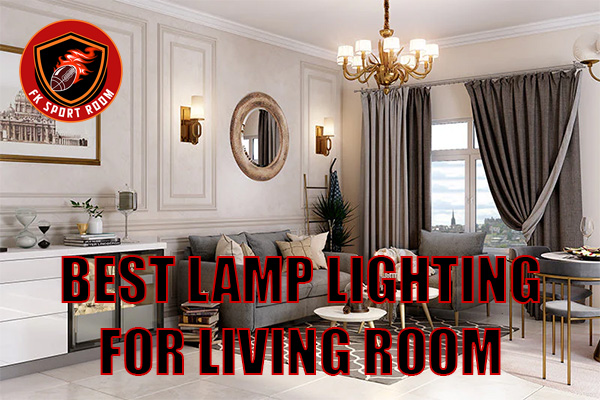Blogs
Best Lamp Lighting for Living Room: Stylish Ideas to Brighten Your Space
Lighting is one of the most powerful tools in interior design. It doesn’t just brighten a room—it sets the mood, enhances décor, and makes a space feel complete. In living rooms, where we relax, entertain, and spend quality time, lighting plays an even bigger role.
The secret to creating a warm, inviting atmosphere lies in layering different types of lighting—and lamps are the stars of the show. In this guide, we’ll explore the best lamp lighting for living room spaces, break down styles, pros and cons, and share tips on pairing lamps with paint colors, furniture, and rugs.

Why lamp lighting matters in living rooms
Unlike overhead lights, lamps bring flexibility, intimacy, and style to your space. Here’s why they’re essential:
- Mood setting: Soft lamp light creates a cozy, relaxing atmosphere.
- Functionality: Perfect for reading corners, side tables, or highlighting art.
- Style statement: Lamps double as décor pieces, adding character and elegance.
- Flexibility: Easy to move, replace, or update compared to built-in fixtures.
Best lamp lighting options for living rooms
Floor lamps – Tall and versatile
Why it works:
Floor lamps add height and presence. They’re perfect for filling empty corners or creating a reading nook.
Styling tips:
- Furniture: Place beside sofas or accent chairs for balance.
- Lighting: Choose warm bulbs for a cozy glow.
- Rugs: A round rug under the lamp base creates definition.
Table lamps – Classic and functional
Why it works:
Table lamps bring light right where you need it—on side tables, consoles, or shelves. They’re also easy to swap out for a quick décor refresh.
Styling tips:
- Furniture: Pair with end tables or a console table behind the sofa.
- Lighting: Use matching lamps on either side of the sofa for symmetry.
- Rugs: Complement with patterned rugs to add visual depth.
Arc lamps – Modern and sculptural
Why it works:
Arc lamps curve dramatically over seating areas, offering overhead light without a ceiling fixture. They’re both functional and artistic.
Styling tips:
- Furniture: Works well with sectional sofas or L-shaped seating.
- Lighting: Choose adjustable heads for flexibility.
- Rugs: Anchor the arc lamp with a large neutral rug to avoid visual clutter.
Tripod lamps – Stylish and sturdy
Why it works:
Tripod lamps are statement pieces with a modern edge. Their three-legged design adds geometry and style.
Styling tips:
- Furniture: Place behind an armchair or in a reading corner.
- Lighting: Pair with neutral lampshades to keep focus on the structure.
- Rugs: A textured rug adds warmth to the sleek design.
Wall-mounted lamps – Space-saving and chic
Why it works:
For small living rooms, wall-mounted lamps free up floor and table space while adding character.
Styling tips:
- Furniture: Install above side tables or near floating shelves.
- Lighting: Adjustable arms allow you to direct light where needed.
- Rugs: Stick with simple rugs so the wall lights remain the highlight.
Pros and cons of lamp lighting
Pros:
- Adds warmth and atmosphere
- Flexible and easy to move
- Decorative element as well as functional
- Variety of styles and price points
Cons:
- Requires outlet access (may need extension cords)
- Bulbs may need frequent replacement
- Can add clutter if overused in a small room
- Some large lamps dominate the space if not balanced
How paint colors influence lamp lighting
Lamp lighting interacts with your wall color, furniture, and textiles, so choosing the right combination matters. Here’s how lamps pair with popular living room paint colors:
Light gray or greige walls
- Furniture: Soft beige or cream sofas to keep things airy.
- Lighting: Warm table lamps prevent the space from feeling cold.
- Rugs: Textured rugs (wool or jute) add depth.
White walls
- Furniture: Bold furniture (navy or emerald green) stands out.
- Lighting: Brass or gold lamps add warmth.
- Rugs: Patterned rugs tie together the pops of color.
Dark accent walls (Navy, charcoal, forest green)
- Furniture: Lighter sofas for balance.
- Lighting: Arc or tripod lamps with bright bulbs keep the space open.
- Rugs: Pale neutral rugs brighten the mood.
Warm beige or taupe walls
- Furniture: Wooden tables and leather sofas enhance warmth.
- Lighting: Amber-toned floor lamps deepen the cozy vibe.
- Rugs: Persian or bohemian rugs for richness.
Soft blue or green walls
- Furniture: White sofas or light oak coffee tables.
- Lighting: Rattan or natural-texture lamps for a breezy feel.
- Rugs: Striped or coastal-inspired rugs complement the color palette.
Practical tips for styling lamp lighting
- Layer your lighting: Mix floor lamps, table lamps, and wall-mounted options for dimension.
- Mind the scale: Tall lamps balance high ceilings, while petite table lamps suit cozy spaces.
- Use dimmers: Adjustable brightness allows you to shift from bright mornings to soft evenings.
- Match shades with decor: Neutral lampshades keep it timeless, while bold colors make a statement.
- Don’t forget corners: A lamp in an unused corner can instantly make a room feel complete.
Frequently Asked Questions
What is the best type of lamp for a small living room?
Wall-mounted lamps or slim floor lamps work best, as they save space while adding plenty of light.
Should I use warm or cool light bulbs in living rooms?
Warm white bulbs (2700–3000K) are ideal. They create a cozy, inviting atmosphere perfect for living areas.
How many lamps should a living room have?
Aim for at least three sources of light: one overhead or arc lamp, one floor lamp, and one or two table lamps. This creates balanced lighting.
Can lamps replace overhead lighting?
Yes—if layered correctly. Multiple lamps can provide sufficient light without needing a central ceiling fixture.
Conclusion
The best lamp lighting for living room depends on your space, style, and needs. Floor lamps add height and drama, table lamps bring intimacy, arc lamps make a statement, and wall-mounted lamps save space.
By coordinating lamps with your paint colors, furniture, and rugs, you’ll create a balanced, stylish, and welcoming space. Don’t just think of lamps as light sources—treat them as essential design elements that bring your living room to life.
With the right lighting choices, your living room won’t just look beautiful—it will feel warm, cozy, and perfectly illuminated for every moment.
